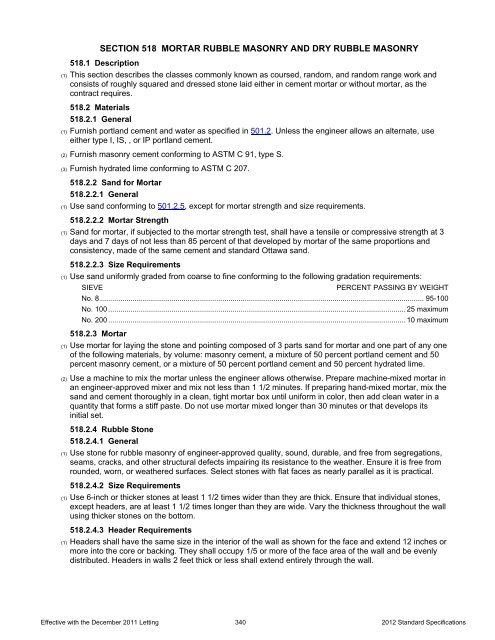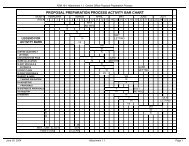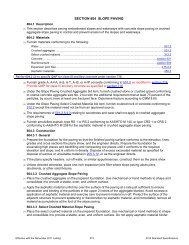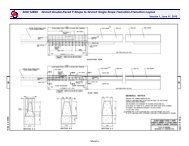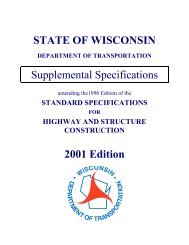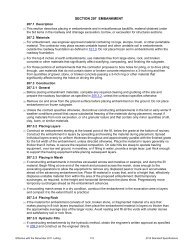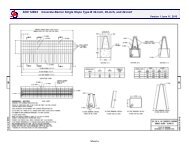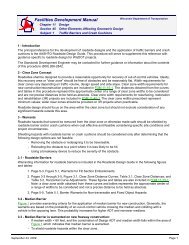12 Spec - Section 518 Mortar Rubble Masonry and Dry Rubble ...
12 Spec - Section 518 Mortar Rubble Masonry and Dry Rubble ...
12 Spec - Section 518 Mortar Rubble Masonry and Dry Rubble ...
You also want an ePaper? Increase the reach of your titles
YUMPU automatically turns print PDFs into web optimized ePapers that Google loves.
SECTION <strong>518</strong> MORTAR RUBBLE MASONRY AND DRY RUBBLE MASONRY<br />
<strong>518</strong>.1 Description<br />
(1) This section describes the classes commonly known as coursed, r<strong>and</strong>om, <strong>and</strong> r<strong>and</strong>om range work <strong>and</strong><br />
consists of roughly squared <strong>and</strong> dressed stone laid either in cement mortar or without mortar, as the<br />
contract requires.<br />
<strong>518</strong>.2 Materials<br />
<strong>518</strong>.2.1 General<br />
(1) Furnish portl<strong>and</strong> cement <strong>and</strong> water as specified in 501.2. Unless the engineer allows an alternate, use<br />
either type I, IS, , or IP portl<strong>and</strong> cement.<br />
(2) Furnish masonry cement conforming to ASTM C 91, type S.<br />
(3) Furnish hydrated lime conforming to ASTM C 207.<br />
<strong>518</strong>.2.2 S<strong>and</strong> for <strong>Mortar</strong><br />
<strong>518</strong>.2.2.1 General<br />
(1) Use s<strong>and</strong> conforming to 501.2.5, except for mortar strength <strong>and</strong> size requirements.<br />
<strong>518</strong>.2.2.2 <strong>Mortar</strong> Strength<br />
(1) S<strong>and</strong> for mortar, if subjected to the mortar strength test, shall have a tensile or compressive strength at 3<br />
days <strong>and</strong> 7 days of not less than 85 percent of that developed by mortar of the same proportions <strong>and</strong><br />
consistency, made of the same cement <strong>and</strong> st<strong>and</strong>ard Ottawa s<strong>and</strong>.<br />
<strong>518</strong>.2.2.3 Size Requirements<br />
(1) Use s<strong>and</strong> uniformly graded from coarse to fine conforming to the following gradation requirements:<br />
SIEVE<br />
PERCENT PASSING BY WEIGHT<br />
No. 8 ............................................................................................................................................................... 95-100<br />
No. 100 .................................................................................................................................................. 25 maximum<br />
No. 200 .................................................................................................................................................. 10 maximum<br />
<strong>518</strong>.2.3 <strong>Mortar</strong><br />
(1) Use mortar for laying the stone <strong>and</strong> pointing composed of 3 parts s<strong>and</strong> for mortar <strong>and</strong> one part of any one<br />
of the following materials, by volume: masonry cement, a mixture of 50 percent portl<strong>and</strong> cement <strong>and</strong> 50<br />
percent masonry cement, or a mixture of 50 percent portl<strong>and</strong> cement <strong>and</strong> 50 percent hydrated lime.<br />
(2) Use a machine to mix the mortar unless the engineer allows otherwise. Prepare machine-mixed mortar in<br />
an engineer-approved mixer <strong>and</strong> mix not less than 1 1/2 minutes. If preparing h<strong>and</strong>-mixed mortar, mix the<br />
s<strong>and</strong> <strong>and</strong> cement thoroughly in a clean, tight mortar box until uniform in color, then add clean water in a<br />
quantity that forms a stiff paste. Do not use mortar mixed longer than 30 minutes or that develops its<br />
initial set.<br />
<strong>518</strong>.2.4 <strong>Rubble</strong> Stone<br />
<strong>518</strong>.2.4.1 General<br />
(1) Use stone for rubble masonry of engineer-approved quality, sound, durable, <strong>and</strong> free from segregations,<br />
seams, cracks, <strong>and</strong> other structural defects impairing its resistance to the weather. Ensure it is free from<br />
rounded, worn, or weathered surfaces. Select stones with flat faces as nearly parallel as it is practical.<br />
<strong>518</strong>.2.4.2 Size Requirements<br />
(1) Use 6-inch or thicker stones at least 1 1/2 times wider than they are thick. Ensure that individual stones,<br />
except headers, are at least 1 1/2 times longer than they are wide. Vary the thickness throughout the wall<br />
using thicker stones on the bottom.<br />
<strong>518</strong>.2.4.3 Header Requirements<br />
(1) Headers shall have the same size in the interior of the wall as shown for the face <strong>and</strong> extend <strong>12</strong> inches or<br />
more into the core or backing. They shall occupy 1/5 or more of the face area of the wall <strong>and</strong> be evenly<br />
distributed. Headers in walls 2 feet thick or less shall extend entirely through the wall.<br />
Effective with the December 2011 Letting 340 20<strong>12</strong> St<strong>and</strong>ard <strong>Spec</strong>ifications
<strong>518</strong>.3 Construction<br />
<strong>518</strong>.3.1 Shaping <strong>and</strong> Dressing Stone<br />
(1) Roughly square the stones on joints, beds, <strong>and</strong> faces. Use stone, roughly squared <strong>and</strong> pitched to line, at<br />
all angles <strong>and</strong> ends of walls. Finish all corners or angles in exterior surfaces with a chisel draft. If placing<br />
a wall stone with a sawed exterior surface, dress it a minimum of 50 percent before placing in the wall.<br />
(2) Perform all stone shaping or dressing before laying the stone in the wall <strong>and</strong> do not allow any dressing or<br />
hammering that might loosen the stone after placement.<br />
<strong>518</strong>.3.2 Laying Stone<br />
<strong>518</strong>.3.2.1 <strong>Mortar</strong> <strong>Rubble</strong> <strong>Masonry</strong><br />
(1) The contractor shall not construct stone masonry in freezing weather, or if the stone contains frost, except<br />
with the engineer’s written permission <strong>and</strong> subject to any conditions required.<br />
(2) Clean each stone surface until free of foreign matter, loose rock grains, <strong>and</strong> rock dust, then saturate with<br />
water before setting. Ensure the bed receiving the stone is clean <strong>and</strong> well moistened. Well bed all stones<br />
in freshly made mortar. Lay the masonry to line in courses roughly leveled up. For the bottom or<br />
foundation, courses use large, selected stones <strong>and</strong> lay all courses with bearing beds parallel to the<br />
natural bed of the material.<br />
(3) Ensure the vertical joints in each course are staggered with those in adjoining courses by at least 6<br />
inches. The contractor shall not locate a vertical joint directly above or below a header.<br />
(4) Make full mortar joints <strong>and</strong> carefully settle the stones in place before the mortar sets. The engineer will<br />
not accept spalls in the beds. Provide joints <strong>and</strong> beds no more than one inch thick.<br />
(5) Always try to properly point the face joints before the mortar sets. If this is not possible, prepare the joints<br />
for pointing by raking them out to a depth of 2 inches before the mortar sets. Take care not to smear the<br />
stone face surfaces with the mortar forced out of the joints, or that used in pointing.<br />
(6) If any stone is moved or the joint broken, take up the stone, thoroughly clean the mortar from the bed <strong>and</strong><br />
joints, <strong>and</strong> reset the stone in fresh mortar.<br />
<strong>518</strong>.3.2.2 <strong>Dry</strong> <strong>Rubble</strong> <strong>Masonry</strong><br />
(1) Lay the masonry to line <strong>and</strong> in courses roughly leveled up. For the bottom or foundation courses use<br />
large, selected stones <strong>and</strong> lay all courses with bearing beds parallel to the natural bed of the material.<br />
Use s<strong>and</strong> for the initial bedding. Face joints shall not exceed one inch in width.<br />
(2) If laying dry rubble masonry, take care that each stone bears firmly on the underlying course at not less<br />
than 3 separate points. Chink open joints, both front <strong>and</strong> rear, with spalls fitted to take firm bearing upon<br />
their top <strong>and</strong> bottom surfaces, to secure firm bearing throughout the stone length.<br />
<strong>518</strong>.3.3 Pointing <strong>Mortar</strong> <strong>Rubble</strong> <strong>Masonry</strong><br />
(1) The contractor shall not perform pointing in freezing weather or if the stone contains frost.<br />
(2) For joints not pointed when laying the stone, thoroughly wet the joint with clean water <strong>and</strong> fill with mortar,<br />
drive the mortar soundly into the joints <strong>and</strong> finish with an engineer-approved pointing tool. Keep the wall<br />
wet while pointing, <strong>and</strong> in hot or dry weather protect the pointed masonry from the sun <strong>and</strong> keep wet for<br />
at least 3 days after completion.<br />
(3) After completing the pointing <strong>and</strong> the mortar sets, clean the wall <strong>and</strong> leave it in a neat, finished condition.<br />
<strong>518</strong>.3.4 Backfill<br />
(1) Backfill shall conform to 206.3.13.<br />
<strong>518</strong>.4 Measurement<br />
(1) The department will measure <strong>Rubble</strong> <strong>Masonry</strong> <strong>Mortar</strong> <strong>and</strong> <strong>Rubble</strong> <strong>Masonry</strong> <strong>Dry</strong> by the cubic yard<br />
acceptably completed.<br />
<strong>518</strong>.5 Payment<br />
(1) The department will pay for measured quantities at the contract unit price under the following bid items:<br />
ITEM NUMBER DESCRIPTION UNIT<br />
<strong>518</strong>.0100 <strong>Rubble</strong> <strong>Masonry</strong> <strong>Mortar</strong> CY<br />
<strong>518</strong>.0200 <strong>Rubble</strong> <strong>Masonry</strong> <strong>Dry</strong> CY<br />
Effective with the December 2011 Letting 341 20<strong>12</strong> St<strong>and</strong>ard <strong>Spec</strong>ifications
(2) Payment for <strong>Rubble</strong> <strong>Masonry</strong> <strong>Mortar</strong> <strong>and</strong> <strong>Rubble</strong> <strong>Masonry</strong> <strong>Dry</strong> is full compensation for excavating; for<br />
preparing the bed; for providing, transporting, <strong>and</strong> placing all materials; <strong>and</strong>, unless the contract specifies<br />
granular backfill, for backfilling.<br />
(3) If granular backfill is required, the department will pay for backfill under the Backfill Granular bid item as<br />
specified in 209.5, or absent that bid item, as extra work.<br />
Effective with the December 2011 Letting 342 20<strong>12</strong> St<strong>and</strong>ard <strong>Spec</strong>ifications


